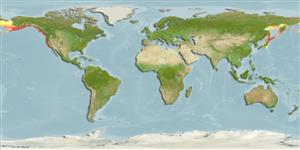Classification / Names
Common names from other countries
Main reference
ขนาด / น้ำหนัก / Age
Max length : 122 cm TL เพศผู้/กระเทย; (Ref. 96339); common length : 60.0 cm TL เพศผู้/กระเทย; (Ref. 5504); น้ำหนักสูงสุดที่มีการรายงาน: 25.4 kg (Ref. 7251); อายุสูงสุดที่ได้รายงาน: 11 ปี (Ref. 12193)
Length at first maturity
Lm ? range ? - ? cm
ภาวะแวดล้อม
; เกี่ยวกับทะเล,น้ำเค็ม; น้ำจืด; กร่อย กลุ่มสัตว์หน้าดิน,กลุ่มสัตว์พื้นท้องน้ำ; ปลาที่อพยพจากแหล่งน้ำเค็มไปวางไข่ในแหล่งน้ำจืด (Ref. 51243); ระดับความลึก 0 - 200 m (Ref. 50550)
สภาพภูมิอากาศ / พิสัย
Subtropical; 10°C - 24°C (Ref. 12741), preferred 8°C (Ref. 107945); 67°N - 32°N, 135°E - 117°W
การแพร่กระจาย
Native to Pacific Slope from Kuskokwim River, Alaska to (at least) Rio Santa Domingo, Baja California, Mexico; upper Mackenzie River drainage (Arctic basin), Alberta and British Columbia in Canada; endorheic basins of southern Oregon, USA. Widely introduced in cold waters elsewhere in North America and rest of the world (Ref. 5723). Eastern Pacific: Kamchatkan Peninsula and have been recorded from the Commander Islands east of Kamchatka and sporadically in the Sea of Okhotsk as far south as the mouth of the Amur River along the mainland. The records outside Kamchatka probably represent migrating or straying Kamchatkan steelhead (penshinensis) rather than the established native population (Reg. 50080). Several countries report adverse ecological impact after introduction.
ประเทศต่างๆ | พื้นที่จำแนกตาม FAO | ระบบนิเวศหลายระบบ | การปรากฏขึ้น,การเกิดขึ้น,พบ | การแนะนำ
Short description
เงี่ยงครีบหลัง (รวม): 0; ก้านครีบอ่อนที่หาง (รวม): 10-12; เงี่ยงครีบก้น 0; ก้านครีบอ่อนที่ก้น: 8 - 12; สัตว์มีกระดูกสันหลัง: 60 - 66. Body elongate, somewhat compressed especially in larger fish. No nuptial tubercles but minor changes to head, mouth and color occur especially in spawning males. Coloration varies with habitat, size, and sexual condition. Stream residents and spawners darker, colors more intense. Lake residents lighter, brighter, and more silvery. Caudal fin with 19 rays (Ref. 2196). Differs from Oncorhynchus gorbuscha by having the following unique characters: by having the following unique characters: anal fin with 6-9½ (usually 8½ ) branched rays; 115-130 scales in midlateral row; 16-17 gill rakers; breeding males lacking hump; juveniles lacking parr marks; wide pink to red stripe from head to caudal base, except in sea-run form; and juveniles with 5-10 parr marks (Ref. 59043).
IUCN Red List Status (Ref. 115185)
Threat to humans
Potential pest
Human uses
การประมง: เน้นการพาณิชย์; การเพาะเลี้ยงสัตว์น้ำ: การค้า; การตกปลาเป็นกีฬา: ใช่
เครื่องมือ
Special reports
Download XML
แหล่งที่มาจากอินเตอร์เน็ต
Estimates of some properties based on models
Phylogenetic diversity index
PD50 = 0.5000 many relatives (e.g. carps) 0.5 - 2.0 few relatives (e.g. lungfishes)
ระดับชั้นอาหาร
4.1 ±0.3 se; Based on diet studies.
ความสามารถในการกลับคืนสู่ปกติ
ขนาดกลาง, เวลาต่ำสุดที่จะทำให้ประชากรเพิ่มขึ้นเป็น 2 เท่าใช้เวลา 1.4 - 4.4 ปี (K=0.38-0.46; tm=2-5; tmax=11; Fec=200)
Vulnerability
Moderate vulnerability (36 of 100)
Price category
